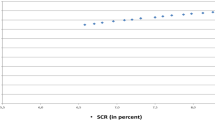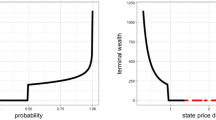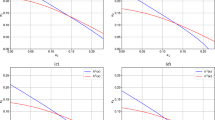Abstract
In the current low interest-rate and highly-regulated environment investing capital efficiently is one of the most important challenges insurance companies face. Certain quantitative parts of regulatory requirements (e.g. Solvency II capital requirements) result in constraints on the investment strategies. This paper mathematically describes the implications of Solvency II constraints on the investment strategies of insurance companies in an expected utility framework with a focus on the market risk module. For this constrained expected utility problem, we define a two-step approach that leads to closed-form approximations for the optimal investment strategies. This proposal circumvents the technical difficulties encountered when applying the convex duality approach or the theory of viscosity solutions. The investment strategies found using the two-step approach can be understood as the optimal investment strategies for constraint problems according to Solvency II. The impact of such constraints on the asset allocation and the performance of these strategies is assessed in a numerical case study.

















Similar content being viewed by others
Notes
Note, that even though the interest-rate r and the liabilities L are assumed to be constant, Solvency II regulators force interest-rate risk constraints on the investment strategies for every \(t \in \left[ 0,T \right] \).
The authors, in their last section “Extensions and ramifications”, pp. 804–805, allow for random constrained regions but under additional strong conditions.
The values have been determined considering mean durations in EIOPA (2013).
All numerical computations in this paper have been computed on a standard PC with an Intel i7 CPU, 2.30 GHz with cache size 5 MB. All codes are written in Matlab R2015a.
All numerical computations in this paper have been computed on a standard PC with an Intel i7 CPU, 2.30 GHz with cache size 5 MB. All codes are written in Matlab R2015a.
References
Bauer, D., Bergmann, D., & Reuss, A. (2010). Solvency II and nested simulations—A least-squares Monte Carlo approach. In Proceedings of the ICA congress.
Bellman, R. (1957). Dynamic programming. Princeton: Princeton University Press.
Bertsekas, D. P. (1995). Dynamic programming and optimal control (Vol. 1). Belmont: Athena Scientific. No. 2, Chapter 1.
Björk, T. (2009). Arbitrage theory in continuous time (p. 255). Oxford: Oxford University Press.
Braun, A., Schmeiser, H., & Schreiber, F. (2015). Portfolio optimization under solvency II: Implicit constraints imposed by the market risk standard formula. Journal of Risk and Insurance, 82, 1–31.
Christiansen, M., & Niemeyer, A. (2012). The fundamental definition of the solvency capital requirement in solvency II. Working Paper, Ulm University.
Cox, J. C., & Huang, C. (1989). Optimal consumption and portfolio policies when asset prices follow a diffusion process. Journal of Economic Theory, 49, 33–83.
Cvitanić, J., & Karatzas, I. (1992). Convex duality in constrained portfolio optimization. The Annals of Applied Probability, 2, 767–818.
de Soto, J. H. (2009). The fatal error of Solvency II. Economic Affairs, 29, 74–77.
Devolder, P., & Lebègue, A. (2016). Risk measures versus ruin theory for the calculation of solvency capital for long-term life insurances. Dependence Modeling, 4(1), 306–327.
Doff, R. (2008). A critical analysis of the Solvency II proposals. Risk Management and Insurance Review, 10, 69–85.
EIOPA (2013). Technical findings on the long-term guarantees assessment appendix 1: Methodology for the calibration of the adaptation (CCP) (as tested in the assessment). EIOPA/13/297.
Eling, M., Schmeiser, H., & Schmit, J. T. (2007). The Solvency II process: Overview and critical analysis. The Geneva Papers on Risk and Insurance Issues and Practice, 33, 193–206.
European Union (2009). Directive 2009/138/EC of the European Parliament and of the Council of 25 November 2009 on the taking-up and pursuit of the business of Insurance and Reinsurance (Solvency II). Official Journal of the European Union, L 335.
European Union (2015). Commission Delegated Regulation (EU) 2015/35 of 10 October 2014 supplementing Directive 2009/138/EC of the European Parliament and of the Council on the taking-up and pursuit of the business of Insurance and Reinsurance (Solvency II) (1). Official Journal of the European Union, L12, Volume 58.
Fischer, K., & Schlütter, S. (2015). Optimal investment strategies for insurance companies when capital requirements are imposed by a standard formula. The Geneva Risk and Insurance Review, 40, 15–40.
Fitch Ratings (2011). Solvency II set to reshape asset allocation and capital markets. Insurance Rating Group Special Report.
Gatzert, N., & Wesker, H. (2012). A comparative assessment of Basel II/III and Solvency II. Geneva Papers on Risk and Insurance, 37, 539–570.
He, H. (1990). Convergence from discrete-to continuous-time contingent claims prices. Review of Financial Studies, 3, 523–546.
Höring, D. (2012). Will Solvency II market risk requirements bite? The impact of Solvency II on insurers’ asset allocation. The Geneva Papers on Risk and Insurance Issues and Practice, 38, 250–273.
Hürlimann, W. (2009). On the non-life Solvency II model. In M. Cruz (Ed.), The Solvency II handbook, Chapter 13, risk books. London: Incisive Media.
Karatzas, I., Lehoczky, J. P., & Shreve, S. E. (1987). Optimal portfolio and consumption decisions for a “small investor” on a finite horizon. SIAM Journal on Control and Optimization, 25, 557–1586.
Kouwenberg, R. (2017). strategic asset allocation and risk budgeting for insurers under Solvency II. Working Paper, Mahidol University and Erasmus University Rotterdam.
Merton, R. (1969). Lifetime portfolio selection under uncertainty: The continuous-time case. The Review of Economics and Statistics, 51, 247–257.
Mittnik, S. (2011). Solvency II calibrations: Where curiosity meets spuriosity, Working Paper.
Pfeifer, D., & Strassburger, D. (2008). Solvency II: Stability problems with the SCR aggregation formula. Scandinavian Actuarial Journal, 2008, 61–77.
Pliska, S. R. (1986). A stochastic calculus model of continuous trading: Optimal portfolios. Mathematics of Operations Research, 11, 371–382.
Rieder, U., & Zagst, R. (1994). Monotonicity and bounds for convex stochastic control models. ZOR Methods and Models for Operation Research, 39, 187–207.
Sandström, A. (2007). Solvency II: Calibration for skewness. Scandinavian Actuarial Journal, 2007, 126–134.
Schubert, T. (2004). Solvency II = Basel II + X. Program on Regulation, Supervision and Legal Issues, 40 .
Steffen, T. (2008). Solvency II and the work of CEIOPS. Geneva Papers on Risk and Insurance, 33, 60–65.
Zagst, R. (2002). Interest-rate management. Berlin: Springer.
Zariphopoulou, T. (1994). Consumption-investment models with constraints. SIAM Journal on Control and Optimization, 32, 59–85.
Acknowledgements
Markus Wahl and Rudi Zagst greatfully acknowledge the support of Allianz Global Investors for this research.
Author information
Authors and Affiliations
Corresponding author
Appendix
Appendix
1.1 Proof of Lemma 1
Let us assume that the Solvency II capital requirements for the different assets are positive, i.e.
The difference between the constraint sets \(\tilde{K}(c,t)\) and K(c, t) is the vector \(\tilde{v}\) on the right-hand side of the inequality in the definition of the constraint set. Per definitionem it holds, that
As the square root function is monotonously increasing and a composition of monotonously increasing functions is also monotonously increasing, let us consider the gradient
Since the matrix WCW is positive-definite \(\nabla g(v)\) is non-negative if and only if
As we assumed that all \(SCR_i\) are positive, which is equivalent to inequality (31), the function
is monotonously increasing in v as a composition of monotonously increasing functions. Hence, using inequality (30), it holds
We can follow that
which concludes the statement
1.2 Proof of Lemma 2
The support function of a convex set is defined as \(\delta (x,c,t):=\sup _{\pi \in K(c,t)}(-\pi ^Tx)\). Let \(t \in \left[ 0,T\right] \) and \(c(t)>0\) be fixed. Let x be inside the barrier cone \(X_{\tilde{K}}=\mathbb {R}^N\). We consider the Lagrangian function
with the Lagrange multiplier \(l \ge 0\). The two conditions are derived as
and
From the first equation we obtain
where we implicitly used \(l>0\). The second condition then becomes
and thus
Now we can conclude again using the symmetry of \(\left( WCW \right) ^{-1}\) that
1.3 Proof of Example 1
First we compute the support function of the set \(K(c,t)=\left\{ \pi (t): c(t) \ge |\pi (t) k| \right\} \) by considering two cases.
Case 1: \(x \ge 0\)
Case 2: \(x \le 0\)
Combining the two cases we see
The optimal dual is calculated by considering the same two cases.
Case 1: \(x \ge 0\)
In order to find the infimum, the derivative of \(f(x):= c(t) \frac{x}{k}+\frac{1}{2}(\tilde{\gamma }+\frac{x}{\sigma })^2(\rho +1)\) is set equal to 0
As we defined \(c(t) \ge 0\) and \(\mu \ge r\) it holds \(x<0\), which violates the assumption of Case 1. As the value function \(c(t)\frac{x}{k}+\frac{1}{2}( \tilde{\gamma }+\frac{x}{\sigma })^2(\rho +1)\) is strictly increasing for \(x>- \frac{c(t) \sigma ^2}{k (\rho +1)}-(\mu -r)\) the solution satisfying the condition of Case 1 is found to be \(x=0\).
Case 2: \(x \le 0\)
In order to find the infimum, the derivative of \(f(x):= -c(t) \frac{x}{k}+\frac{1}{2}(\tilde{\gamma }+\frac{x}{\sigma })^2(\rho +1)\) is set equal to 0
This solution fulfills the condition of Case 2, if
If this does not hold true the optimal solution is again \(x=0\) as the value function is strictly decreasing for \(0 \le \frac{c(t) \sigma ^2}{k (\rho +1)}-(\mu -r) \).
Combining the two cases, it holds
Using the result from Chapter 2, the optimal investment strategy is found as
1.4 Proof of Proposition 3
In Sect. 3 it has been shown, that for a constant c the wealth process \(V^*_t(c)\) behaves like a Geometric Brownian motion with constant drift and diffusion
Due to the exponential structure of the solution of the SDE, the minimum of such a Geometric Brownian motion can be written as
where \(R_t= \tilde{\mu }t + \tilde{\sigma }W_t\) is a Wiener process with drift \(\tilde{\mu }\) and diffusion \(\tilde{\sigma }\)
Analyzing the distribution of the RALC process, we find
where the distribution function of the running minimum of \(R_t\) is taken from Björk (2009), p. 209.
Rights and permissions
About this article
Cite this article
Escobar, M., Kriebel, P., Wahl, M. et al. Portfolio optimization under Solvency II. Ann Oper Res 281, 193–227 (2019). https://doi.org/10.1007/s10479-018-2835-x
Published:
Issue Date:
DOI: https://doi.org/10.1007/s10479-018-2835-x




